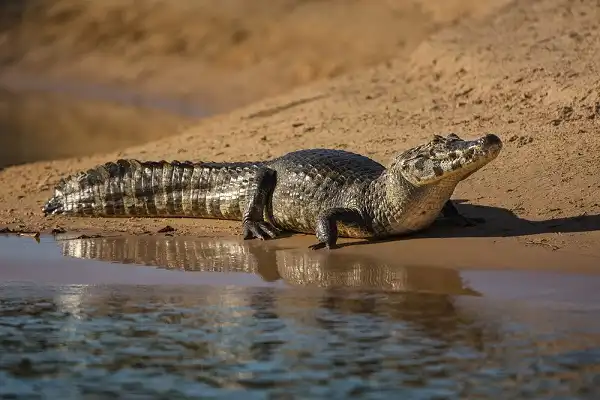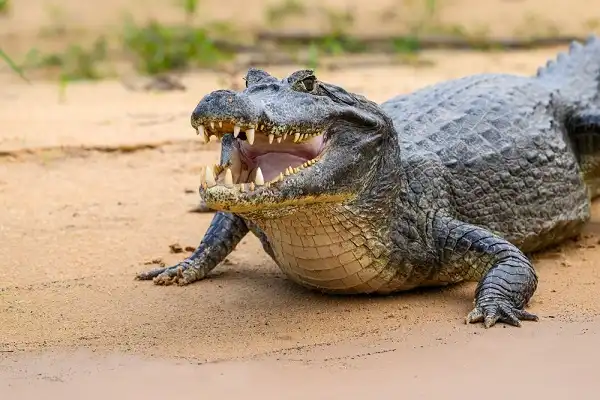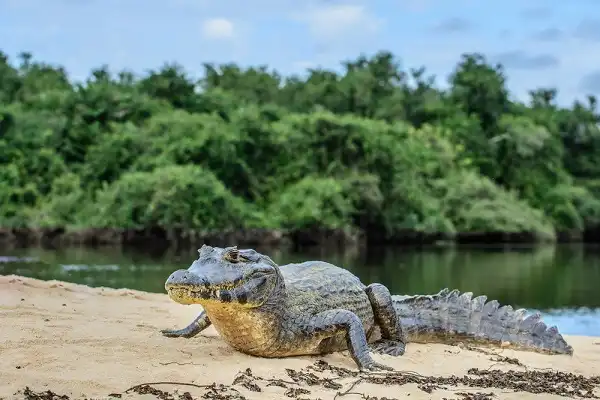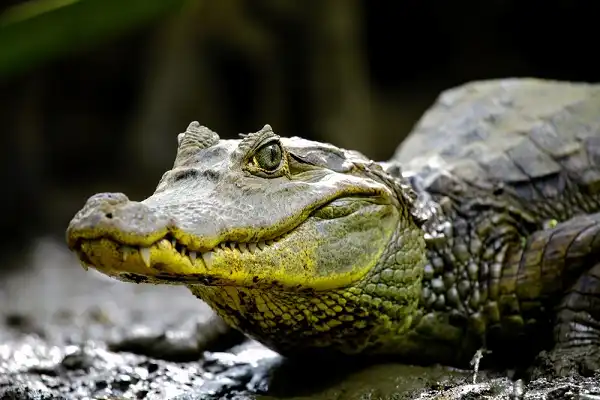Do you know much about caimans? These ancient creatures are part of the crocodilian family and include both fossilized species from millions of years ago as well as seven modern living species. With the mix of prehistoric features, unique habitats, and fascinating behavior, caimans provide an incredible tale worth exploring. Join us here to learn all about these animals that have adapted for so long in a world full of change!

Caiman Description
Caimans are a variety of crocodilians, possessing similar physical traits to alligators and crocodiles. Largely aquatic creatures, caimans possess long snouts, sharp teeth, and powerful tails, which help them navigate through the water quickly. A notable feature of caimans is their tough scales which act as armor against potential predators. The coloration of caimans ranges from dark green to tan or black depending on the species. They also have webbed feet in order to aid in movement within the water.
Caiman Habitat
Caimans can be found in a variety of different habitats ranging from rivers and streams to estuaries, marshes, swamps, and lake systems. Depending on the species, caimans will prefer one type of habitat over another. For example, Black Caimans typically inhabit freshwater areas such as lakes and rivers within South America’s Amazon basin while Spectacled Caimans prefer living near brackish water areas such as estuaries or marshes.
Additionally, they gain shelter from predators thanks to their strong scales and their ability to remain submerged in the water for long periods of time. Caimans also display incredible adaptability when it comes to their habitat preferences as some species are able to live in both saltwater and freshwater environments. This is especially beneficial during the dry season when large bodies of water shrink and caimans must find alternate sources of habitation.
Caiman Diet
Caimans primarily have carnivorous diets, feeding on a variety of animal prey. This includes small mammals, birds, fish, reptiles and amphibians. Depending on the species, caimans have been known to scavenge carrion or even feed on fruits and nuts when available. The diet of a caiman is largely determined by its habitat and size. Smaller caimans will typically feed on insects, frogs, and other smaller prey while larger specimens may hunt down large mammals such as capybaras or even aquatic birds. Caimans have also been known to consume their own young if food is scarce or resources are limited.

Caiman Size
Caiman size varies widely among species. Spectacled Caimans typically range between 1.2-1.8 meters (4-6 feet) in length while Black Caimans can reach up to 4 meters (13 feet). Females are generally smaller than males, with the largest recorded female Black Caiman measuring 3 meters (10 feet). Caimans feature a diverse range of body shapes, depending on where they live and what type of prey they consume. Those that inhabit swamps may have flatter bodies and more pronounced snouts in order to help them navigate through the water with ease. Meanwhile, caimans living near rivers may have slimmer bodies and long tails to help them swim rapidly against strong currents.
Caiman Lifespan
Caiman lifespan can vary greatly depending on species, habitat, and other factors. The average caiman will typically live between 15 to 30 years in the wild, although some specimens have been known to live up to 50 years. In captivity, they can survive even longer with the record for the longest-living caiman being a Black Caiman who lived for over 70 years in an aquarium! Generally speaking, larger caimans tend to have longer lifespans than their smaller counterparts. This is because they have more access to food resources and are better equipped to defend themselves from predators. Additionally, those that inhabit areas of higher humidity and warmer temperatures tend to outlive those inhabiting colder climates due to metabolic rates being affected by temperature. Caimans reach sexual maturity around 5 or 6 years of age which is when their growth rate begins to slow down significantly as well. After this point, they remain relatively unchanged for most of their lives with the exception of slight weight variations due to food availability or environmental factors such as droughts.
Caiman Behavior
Caiman behavior is largely influenced by their habitat and diet. Generally, they are solitary creatures that can be found basking in the sun or swimming for long distances. During the day, they like to stay close to water sources where they can ambush unsuspecting prey as it passes by. At night, caimans may venture out of the water to search for food on land. Caimans also display territorial behaviors which involve marking their boundaries with scents and sounds in order to deter other caimans from entering their territory. Males tend to be more aggressive than females when it comes to defending their territory from intruders but both genders will display similar behaviors when it comes to protecting their young from harm. Overall, caiman behavior is mainly dictated by instinct and survival instincts-based decision-making. They possess impressive physical traits such as powerful jaws and sharp claws which allow them to hunt efficiently while also providing protection against potential threats.

Caiman Speed
Caiman speed is an impressive physical trait that helps these reptiles to survive within their respective habitats. Depending on the species and size, caimans can reach speeds anywhere from 10 mph to 25 mph when moving in short bursts. This allows them to quickly ambush their prey and outrun potential predators. When in water, caimans are able to swim at a more leisurely pace, usually between 3 and 7 mph. However, they are capable of bursts of speed up to 15 mph if needed when chasing down food or fleeing from danger! Caimans also possess webbed feet which help them maneuver through water with greater agility and fluidity than other aquatic animals. In addition to their impressive swimming speeds, caimans are also fast runners on land. When on dry land, they can reach top speeds of up to 18 mph while running for short distances! While these reptiles are not as graceful as some of their four-legged counterparts such as cheetahs or wolves, they have enough speed to easily outpace most humans and other potential predators in pursuit of prey or safety.
Caiman Hunting
Caiman hunting relies heavily on their impressive physical traits and speed. These reptiles mainly rely on ambush tactics to catch their prey, using their powerful jaws and sharp claws to grab onto it tightly until it succumbs to death or injury. Caimans are also proficient hunters on both land and water, using their strong webbed feet to move quickly. When hunting in the water, caimans will often use some kind of camouflage or cover such as fallen logs or aquatic vegetation to hide from potential prey before swiftly ambushing them upon approach. On land, they may employ similar tactics by hiding in tall grasses or brush before sprinting forward with lightning speed in order to capture unsuspecting creatures that pass by too close. Caimans have been known to hunt a variety of different animals including fish, amphibians, reptiles, small mammals, birds, and even other larger caimans! They are also opportunistic feeders that will consume whatever animal is most readily available within their habitats.
Caiman Reproduction
Caimans are polygynous, meaning one male can mate with multiple females. During mating season, males will become highly territorial and establish large territories in order to attract as many females as possible. Females lay anywhere from 10-50 eggs and then guard the nest until they hatch about 2 months later. Once hatched, caiman younglings are independent and ready to live on their own. Caiman populations have been known to fluctuate due to overhunting and habitat destruction, making them vulnerable to extinction if not properly monitored and protected. As a result, many countries have specific laws in place to help with conservation efforts. For example, in the U.S., only certified wildlife rehabilitators and zoos are allowed to keep caimans as pets. Not following these laws can result in fines or jail time!

Conclusion
Caimans are impressive reptiles that possess a wide array of physical traits and behaviors that allow them to survive in their respective habitats. Their speed and agility enable them to both hunt efficiently as well as outrun potential predators, while their powerful jaws and sharp claws provide them with an effective means of capturing prey. Additionally, caimans are highly territorial animals that will protect their territories fiercely in order to ensure the safety of themselves and their young! All of these attributes combined make caimans some truly remarkable creatures that are perfectly suited for life in the wild!
Frequently Asked Question

